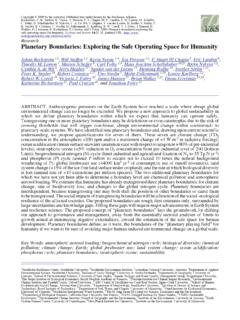Transcription of Flexible working qualitative analysis - GOV.UK
1 Flexible working qualitative analysis Organisations experiences of Flexible working arrangements March 2019 Leonie Nicks, Hannah Burd and Jessica Barnes The Behavioural Insights Team 2 Contents List of figures 5 List of tables 5 Executive summary 6 Study aim 6 HR perceptions of Flexible working 6 Barriers and facilitators of Flexible working 6 Conclusions 7 Introduction 9 Flexible working in the UK 9 Study aims 10 Methodology 10 Topic of research 10 Semi-structured in-depth interviews 10 Sampling 11 Analytical approach 12 Interpreting this research 12 Report structure 13 1.
2 What is Flexible working ? 15 2. Individual 17 Employees value Flexible working 17 Flexible working helps attract and retain employees 18 Demand for Flexible working varies by gender and generation 19 Concerns about progression act as a deterrent 19 Conclusion: Flexible working is seen as a privilege 20 3. Manager and team 22 Teams 22 Managers 23 Managers mostly support Flexible working , but some can be cynical 23 Experiences with Flexible working can change managers minds 24 3 Strong manager-employee relationships facilitate Flexible working 24 Strong people management skills facilitate Flexible working 25 Some teams are limited in how far they can work flexibly 25 Conclusion: Strong managers are critical for empowering teams to work flexibly 26 4.
3 Organisation 27 Culture 27 Organisational leadership set strategic priorities that inform culture 28 Role modelling is important for groups that have traditionally not worked flexibly 29 Flexible working is perceived as only for mothers 30 Making Flexible working the default assimilates it into the culture 30 Organisational culture can be resistant to Flexible working 31 Conclusion: Successful Flexible working requires a culture that enables it 32 Corporate policies 33 HR prioritise widening access to Flexible working 33 HR can facilitate Flexible working through the design of the request process 33 HR can be limited in how far they can make change 34 HR are hesitant to advertise all job roles as Flexible 35 Technology is an enabler of Flexible working 35 Designing a strong resourcing strategy is critical to Flexible working success 36 Some types of Flexible working pose greater challenges
4 To resourcing 37 It is possible to overcome resourcing constraints 38 Some roles are less compatible with Flexible working 38 The relationship between seniority and Flexible working is unclear 39 Conclusion: Corporate policies play an important role in embedding Flexible working 40 Conclusion: A culture of Flexible working ensures corporate policies are implemented 40 5. Society 42 Societal norms can create barriers to uptake of Flexible working 42 Gender norms make Flexible working seem exclusive to women 43 Men are deterred from working flexibly for fear of damaging their career 43 Gender norms are changing 44 Organisations are constrained by external demands and infrastructure 45 4 Conclusion: Society shapes social expectations and available infrastructure 45 Conclusion 46 Glossary 49 Appendix A 50 5 List of figures Figure 1.
5 Spheres of influence 14 List of tables Table 1 Summary findings 7 Table 2 Size and sector of participating organisations 11 Table 3 Sample detailed characteristics 50 6 Executive summary Flexible working , defined by the UK government as a way of working that suits an employee s needs , is critical for improving workplace gender equality. Women do the majority of unpaid care work in the UK and so the majority of Flexible workers are women. While the impact of other Flexible working arrangements is yet to be well understood, the negative impact of part-time working disproportionately affects women s careers and contributes to the gender pay gap.
6 The challenge of widening access to and successful implementation of Flexible working arrangements for both men and women faces employers across many sectors. Yet it could be the key to women s retention and progression at work and gender equality across society as a whole. Study aim The main aim of this study was to identify key barriers and facilitators for organisations offering Flexible working , and the key barriers and facilitators to employees taking up or accessing Flexible working . We examined this from the perspective of Human Resources (HR) professionals.
7 Semi-structured in-depth interviews were carried out with 20 HR professionals. The organisations involved were of a range of sizes and sectors selected to achieve a likely diversity in Flexible working availability and uptake. HR perceptions of Flexible working HR professionals understood Flexible working as flexibility in relation to when and where employees work their hours. Arrangements could involve either a formal change to the contract or an informal agreement between employee and line manager. Most types of Flexible working arrangement were made available to employees in principle.
8 Uptake was fairly low for formal arrangements, but there was a sense that informal uptake was much higher. Barriers and facilitators of Flexible working Four spheres of influence emerged from the data at the individual, manager and team, organisation and society levels. Each sphere of influence determined key barriers and facilitators for both offering and taking up Flexible working . 7 Table 1 Summary findings Sphere of influence Impact on Flexible working Individual Employees can shape the Flexible working arrangements made available by their organisation by the demands they make Their uptake of Flexible working is influenced by how they perceive it fits with their identity and needs Manager and team Teams that individual employees work in can facilitate the successful uptake of Flexible working Managers play a critical role in the success of Flexible working Organisation
9 Organisations control their Flexible working offering and influence their employees uptake through the cultural norms of the organisation and its corporate policies Society Society influences the uptake and offering of Flexible working through societal norms and the availability of infrastructure to support Flexible workers Conclusions The insights from this research enabled us to identify behavioural solutions to improve the uptake of Flexible working across three areas. We have identified a need to: Support individuals who make a Flexible working request by simplifying and signposting the process for employees.
10 This process needs to be made as easy and attractive as possible. Requests should be automatically monitored by HR to ensure none are privately rejected by line managers. Support managers to implement Flexible working by providing meaningful guidance or trial periods to help them to consider and envisage how to implement Flexible working patterns in their team. Guidance could address how to scale workloads and objectives appropriately. Prompt open conversations about work-life balance and preferred working styles with employees, including at timely moments such as before and after parental leave.














